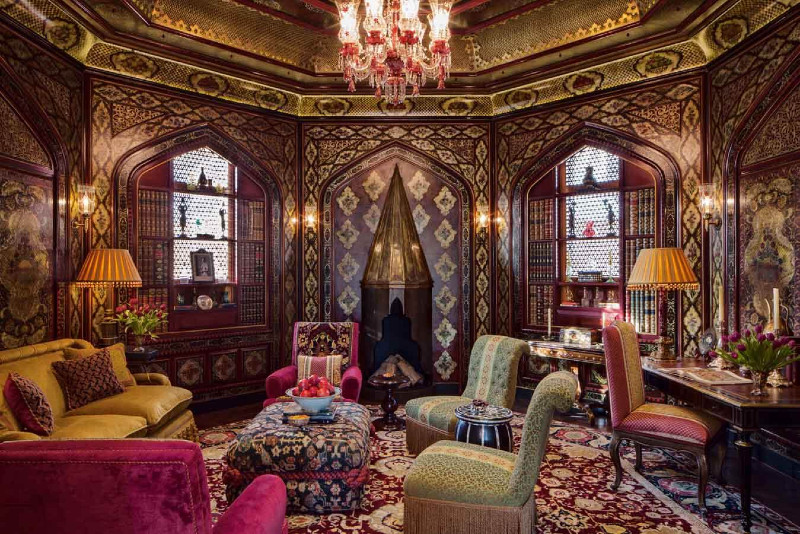Middle Eastern home decor is an enchanting blend of history, culture, and artistic flair. Drawing from thousands of years of civilization, it is characterized by its vibrant colors, intricate patterns, and rich textures. Having traveled extensively through the Middle East and incorporated these elements into my own home, I would love to share my insights and experiences with you. Let’s explore the beauty of Middle Eastern decor together!
Understanding Middle Eastern Home Decor
The essence of Middle Eastern decor lies in its deep cultural roots. Each country in the region brings its unique style, influenced by various historical events and traditions. Here, we’ll break down the key elements that define Middle Eastern home decor.
Key Elements of Middle Eastern Decor
- Patterns and Textiles: Richly patterned fabrics, carpets, and wall hangings.
- Color Schemes: Use of warm, inviting colors like reds, golds, and deep blues.
- Lighting: Intricate lanterns and ambient lighting create a warm atmosphere.
- Furniture: Low seating arrangements, ornate wooden pieces, and multi-purpose furniture.
- Art and Decor: Use of calligraphy, mosaics, and handmade ceramics.
Exploring the Different Styles of Middle Eastern Decor

1. Moroccan Decor
Moroccan decor is perhaps the most recognized Middle Eastern style. It’s known for its bold colors, intricate tile work (zellige), and elaborate lanterns.
- Colors: Rich jewel tones like sapphire, emerald, and ruby.
- Materials: Natural materials like clay, wood, and iron.
Pros and Cons of Moroccan Decor
| Pros | Cons |
|---|---|
| Vibrant and inviting | Can be overwhelming if overdone |
| Unique artisan craftsmanship | Requires maintenance to keep colors fresh |

2. Persian Decor
Persian decor reflects a rich cultural heritage with its emphasis on artistry and elegance. Persian rugs are famous worldwide, and floral patterns are common.
- Colors: Earth tones mixed with brighter shades.
- Materials: Wool and silk textiles.
Pros and Cons of Persian Decor
| Pros | Cons |
|---|---|
| Timeless elegance | Expensive, especially authentic pieces |
| Adds cultural depth | High maintenance for upkeep |

3. Turkish Decor
Turkish decor blends old-world charm with contemporary style, featuring bold patterns in textiles and ceramics.
- Colors: Bright hues mixed with intricate designs.
- Materials: Handcrafted pottery and textiles.
Pros and Cons of Turkish Decor
| Pros | Cons |
|---|---|
| Unique artisan pieces | May clash with minimalist styles |
| Rich cultural narrative | Can be pricey depending on authenticity |

Designing Your Home with Middle Eastern Influences
Now that we’ve explored the different styles, let’s discuss how you can blend these influences into your own home. Here are some tips based on personal experiences:

1. Start with a Color Palette
Choose a warm color palette that resonates with Middle Eastern aesthetics. Use deep reds, oranges, and browns as bases, adding accents of gold or turquoise.
2. Invest in Textiles
Fabrics can transform your space instantly. Consider adding Turkish cushions, Moroccan poufs, or Persian runners to your decor.

3. Mix and Match
Don’t hesitate to combine styles! A Moroccan lamp can beautifully complement a Persian rug. Experimenting is key to achieving the desired look.
4. Use Lighting Creatively
Lighting is crucial in Middle Eastern decor. Try using ornate lanterns or string lights to create an inviting atmosphere. Soft, warm lighting enhances the beauty of textured fabrics and intricate patterns.
5. Incorporate Art Pieces
Incorporate artwork that reflects Middle Eastern culture. Look for calligraphy art, hand-painted ceramics, or even framed rugs as wall decor to add a personal touch.
Buying Guide: Where to Find Authentic Middle Eastern Decor
When purchasing Middle Eastern decor, authenticity is key. Here’s a handy buying guide:
- Local Markets: Explore local markets for unique finds.
- Online Stores: Websites like Etsy and local artisans often offer handcrafted items.
- Import Stores: Look for stores specializing in import goods for authentic decor.
Comparison Table: Key Decor Elements Across Styles
| Feature | Moroccan | Persian | Turkish |
|---|---|---|---|
| Color Palette | Bold, vibrant | Earthy, mixed | Bright, intricate |
| Textiles | Bright patterned fabrics | Wool and silk rugs | Handcrafted ceramics and fabrics |
| Furniture | Low seating, ornate | Elegant wooden pieces | Multi-purpose, vivid |
Common FAQs About Middle Eastern Home Decor
What are the most common materials used in Middle Eastern decor?
The most common materials include wood, clay, metal, and textiles like silk and wool.
How can I incorporate Middle Eastern decor on a budget?
Look for DIY projects, shop at local thrift stores, or purchase smaller decor items like cushions or wall art.
Where can I find authentic Middle Eastern rugs?
Authentic Middle Eastern rugs can be found in dedicated rug shops or online marketplaces specializing in handcrafted items.
Is Middle Eastern decor suitable for modern homes?
Absolutely! Middle Eastern decor can blend beautifully with modern styles to create a unique and inviting atmosphere.
Can I mix different Middle Eastern styles in my home?
Yes, mixing different styles can enhance the overall look and allow for personal expression while still reflecting Middle Eastern influences.
Conclusion
Incorporating Middle Eastern home decor into your space can transform your home into a warm and inviting environment that reflects history and culture. Use this guide as a starting point to embrace the beauty of Middle Eastern design. Your space can become a breathtaking amalgamation of cultures, colors, and art that tells a story of its own. Happy decorating!